Aorus GeForce GTX 1080 Plus 11Gbps Review
Manufacturer: AorusUK price (as reviewed): £549.98 (inc VAT)
US price (as reviewed): TBC
When Nvidia announced the GTX 1080 Ti, it also slipped in news of a price cut for the GTX 1080 as well as a new SKU for it that would feature faster memory, prolonging the lifespan of Pascal still further and segmenting the high-end GPU marketplace a bit more – Nvidia is currently free to do as it pleases at this price. We're starting to see these new, faster GTX 1080s trickle out now, and with us today is one of two from Aorus. The new cards may be referred to as 'GTX 1080 Plus' by retailers for distinction, but the 'Plus' is absent from official documentation and packaging, so we've excluded it here too.
We saw an Aorus GTX 1080 Ti recently, and this card is really rather similar. If you haven't been keeping up, Aorus is essentially code for flagship Gigabyte produce. The card is supplied without accessories except for a single dual-6-pin PCI-E to 8-pin PCI-E power adaptor.
Factory overclocks are a given on Aorus parts, and this card runs out-the-box at a base clock of 1,709MHz (boost 1,848MHz), which is 102MHz - six percent - quicker than reference speeds. With the Aorus Engine software, you can also set the card to its built-in OC Mode, adding 25MHz to both clock speeds in the process, or to Silent Mode, which drops the card to Nvidia reference clocks. In all modes, the 8GB of GDDR5X memory remains fixed at the new, faster speed of 1.375GHz (11Gbps effective). This 10 percent bump to memory speed (and thus memory bandwidth) is the only difference between these new 'Plus' SKUs and the older, regular GTX 1080 stock.
Aorus ventures beyond the Nvidia reference set of display outputs, adding two internal HDMI 2.0b ports to the standard trio of DisplayPort 1.4 headers, single dual-link DVI-D, and default HDMI 2.0b output at the rear I/O. The internal ports can be routed to front panel connectors that allow easy connection of VR headsets, although we're not sure what the benefit of two is over one. Four displays/devices is still the limit at any one time, but there's clearly a lot of flexibility here. Outputs are auto-detected at boot: Connecting the DVI-D port will automatically disable the two internal HDMI outputs, otherwise the card will run in VR Mode with all three DisplayPort headers and all three HDMI ports available for use.
Power comes in through a pair of 8-pin PCI-E power plugs which are indented in the PCB – handy as the card is very tall as it is. It's also large in every other dimension being almost 300mm long and requiring three expansion slots. We prefer it when companies are able to keep their designs within the dual-slot form factor but appreciate that in many systems the graphics card will be the only expansion card installed.
The metal cooler shroud is intersected by a plastic cross that's RGB-lit, and the Aorus logo along the top also receives the RGB treatment. The logo cut into the backplate, however, does not. Through Gigabyte's RGB Fusion software, you can synchronise the RGB LEDs with those on other supported bits of Gigabyte or Aorus hardware.
If thermals are a primary concern for you, Aorus goes further than anyone else we've seen in looking after the card's components. The main heatsink has a massive copper baseplate that directly cools the GPU and VRAM, while further padding ensures the MOSFETs, capacitors, and chokes that make up the GPU power phases are all directly cooled too. Aorus also boats of the thermal benefits of its angular heatsink fins and composite heat pipes – such claims are impossible for us to verify, but with six heat pipes and two massive fin stacks, the cooler here certainly looks potent, and it's already proven its worth on the more power-hungry GTX 1080 Ti.
The metal backplate is a must given the card's size and weight, but it also adds a nice aesthetic touch, and Aorus uses it for cooling too. The part covering the back of the GPU is copper for additional heat transfer, and there are even grooves cut into the copper intended to help shift heat via air passing over the backplate. Meanwhile, yet more padding connects the backplate to the rear of where the VRM circuitry sits – we told you Aorus was thorough.
Airflow is generated by a trio of 100mm fans, with Aorus stacking the outer two over the middle one (which also spins in the opposite direction) in order to keep the length below 300mm. This 'WindForce Stack' arrangement uses fans with the latest Aorus design tweaks, including double ball bearing internals and a blade design with grooves that are said to split and direct the airflow more effectively. Semi-passive functionality is supported, and all three fans will thus switch off when the GPU is cool enough – the 'Fan Stop' logo will then illuminate.
A massive 12+2 phase power configuration feeds voltage to the GPU and memory, with Aorus here using the same chokes and capacitors you'd find on Titan X cards. The PCB is manufactured on a fully automated process and given a so-called 'aerospace-grade' coating to boost resistance against dust, moisture, and corrosion.
Specifications
- Graphics processor Nvidia GeForce GTX 1080, 1,709MHz (1,848MHz boost)
- Pipeline 2,560 stream processors, 160 texture units, 64 ROPs
- Memory 8GB GDDR5X, 11Gbps effective
- Bandwidth 352GB/sec, 256-bit interface
- Compatibility DirectX 12, Vulcan, OpenGL 4.5
- Outputs/Inputs 3 x DisplayPort 1.4, 1 x Dual Link DVI-D, 1 x HDMI 2.0b, 2 x internal HDMI 2.0b
- Power connections 2 x 8-pin PCI-E, top-mounted
- Size 293mm long, 142mm tall, triple-slot
- Warranty Three years

MSI MPG Velox 100R Chassis Review
October 14 2021 | 15:04


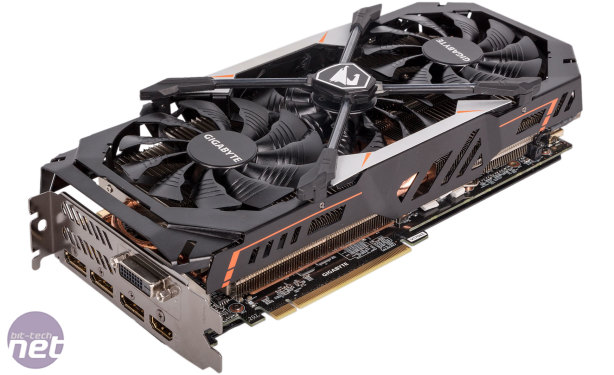
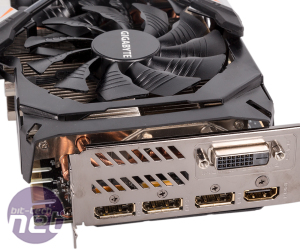
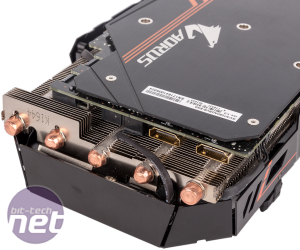

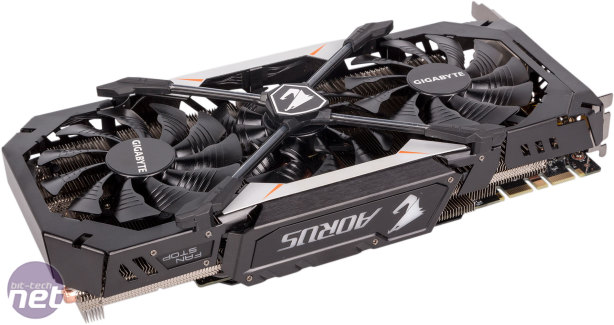
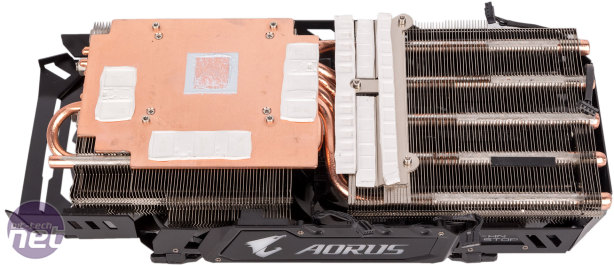

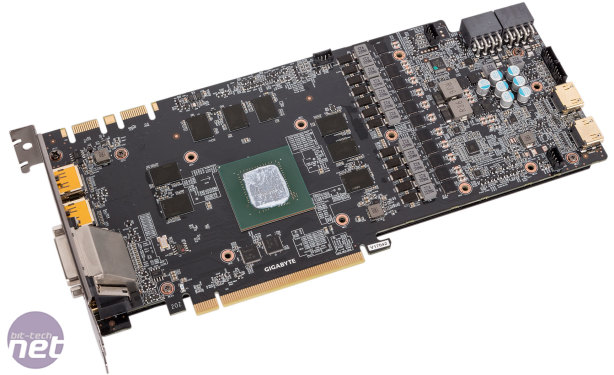







Want to comment? Please log in.